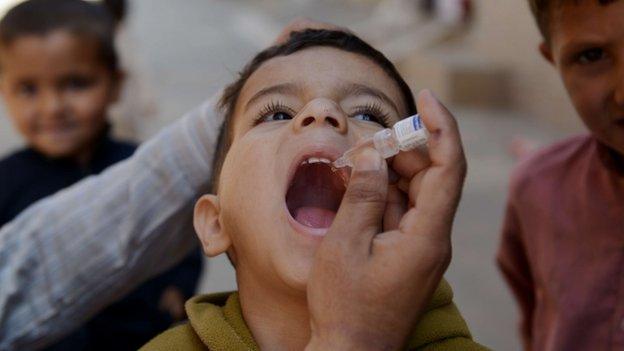Pakistan gunmen kill four polio workers in Quetta
- Published

The polio team were attacked before joining their security detail
Four polio vaccination workers have been shot dead and three injured in the south-west Pakistani city of Quetta.
Police said the three female health workers and their male driver were attacked by two gunmen on a motorbike. Anti-polio efforts in the province have been suspended, the authorities say.
The shootings are the latest in a series targeting Pakistani polio teams. No group has claimed responsibility.
Militants say polio teams are spies or that the vaccine causes infertility.
Pakistan is one of only three countries where the disease is still endemic, the others being Nigeria and Afghanistan.
Pakistan's National Co-ordinator for Polio Eradication, Ayesha Raza Farooq, told the BBC it was a "cowardly attack". She said the shootings happened as the workers walked a short distance to a rendezvous with their security detail.
"There was going to be security with this team before they went in and started their work. However, no one could have thought that this team would be intercepted," she said.
More than 60 Pakistani polio workers, or their guards and drivers, have been killed since 2012 - with most attacks blamed on Islamic extremists, the BBC's M Ilyas Khan reports from Islamabad.
Police officer Imran Qureshi told the BBC that two of the workers, both women, died on the spot, while two others died later of injuries sustained in the attack.
Pakistan has so far reported 260 new cases of polio this year, its highest number since 2000.

Polio

Poliomyelitis mainly affects children under five
Invades the nervous system and can cause total paralysis within hours
One in 200 infections leads to irreversible paralysis
Polio cases have decreased by more than 99% since 1988
Endemic in three countries - Afghanistan, Nigeria and Pakistan
There is no cure but the virus can be prevented by immunisation


Poliomyelitis has existed as long as human society, but became a major public health issue in late Victorian times with major epidemics in Europe and the United States. The disease, which causes spinal and respiratory paralysis, can kill and remains incurable but vaccines have assisted in its almost total eradication today.

This Egyptian stele (an upright stone carving) dating from 1403-1365BC shows a priest with a walking stick and foot, deformities characteristic of polio. The disease was given its first clinical description in 1789 by the British physician Michael Underwood, and recognised as a condition by Jakob Heine in 1840. The first modern epidemics were fuelled by the growth of cities after the industrial revolution.

In 1916, New York experienced the first large epidemic, with more than 9,000 cases and 2,343 deaths. The 1916 toll nationwide was 27,000 cases and 6,000 deaths. Children were particularly affected; the image shows child patients suffering from eye paralysis. Major outbreaks became more frequent during the century: in 1952, the US saw a record 57,628 cases.

In 1928, Philip Drinker and Louie Shaw developed the "iron lung" to save the lives of those left paralysed by polio and unable to breathe. Most patients would spend around two weeks in the device, but those left permanently paralysed faced a lifetime of confinement. By 1939, around 1,000 were in use in the US. Today, the iron lung is all but gone, made redundant by vaccinations and modern mechanical ventilators.

A major breakthrough came in 1952 when Dr Jonas Salk (L) began to develop the first effective vaccine against polio. Mass public vaccination programmes followed and had an immediate effect; in the US alone cases fell from 35,000 in 1953 to 5,300 in 1957. In 1961, Albert Sabin (R) pioneered the more easily administered oral polio vaccine (OPV).

Despite the availability of vaccines polio remained a threat, with 707 acute cases and 79 deaths in the UK as late as 1961. In 1962, Britain switched to Sabin's OPV vaccine, in line with most countries in the developed world. There have been no domestically acquired cases of the disease in the UK since 1982.

By 1988, polio had disappeared from the US, UK, Australia and much of Europe but remained prevalent in more than 125 countries. The same year, the World Health Assembly adopted a resolution to eradicate the disease completely by the year 2000.

The WHO Americas region was certified polio free in 1994, with the last wild case recorded in the Western Pacific region (which includes China) in 1997. A further landmark came in 2002, when the WHO certified the European region polio-free.

In 2012, Polio remains officially endemic in four countries - Afghanistan, Nigeria, Pakistan and India, which is on the verge of being removed from the list having not had a case since January 2011. Despite so much progress, polio remains a risk with virus from Pakistan re-infecting China in 2011, which had been polio free for more than a decade.
- Published23 November 2014

- Published27 May 2014

- Published4 October 2014

- Published24 October 2014

- Published10 May 2014

- Published18 December 2012

- Published25 September 2015
